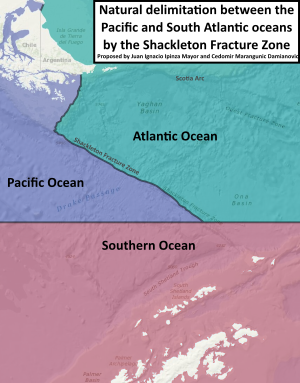Natural delimitation between the Pacific and South Atlantic oceans by the Shackleton Fracture Zone
This article was nominated for deletion. The discussion was closed on 25 December 2023 with a consensus to merge the content into the article Shackleton Fracture Zone. If you find that such action has not been taken promptly, please consider assisting in the merger instead of re-nominating the article for deletion. To discuss the merger, please use the destination article's talk page. (December 2023) |
The natural delimitation between the Pacific and South Atlantic Oceans by the Shackleton Fracture Zone is the title of a scientific theory developed in Chile and other countries in which it is postulated that the boundary between the southeastern Pacific Ocean and the southwestern Atlantic Ocean would not be the so-called Cape Horn meridian, but is the Shackleton Fracture Zone, mid-oceanic ridge[1] and submarine orographic chain which links the Tierra del Fuego Archipelago with the Antarctic continent. It also considers the conventional border of the Southern Ocean at the 60°S parallel.[2]

Scientific theory edit
The researchers Juan Ignacio Ipinza Mayor and Cedomir Marangunic Damianovic put forward the scientific theory that the separation of the Pacific and Atlantic Ocean oceans "could be confirmed from the so-called Shackleton Fracture Zone (...) the boundary is then located east of the so-called Cape Horn Meridian".[3]
In 2019, the scientific journal Geology is News published "The SFZ separates tectonic plates and oceans, to the east the Scotia Plate and to the west the Antarctic Plate (which includes the former Phoenix Plate), and to the east the Pacific Ocean and to the west the Atlantic Ocean."[4]
In 2004 The Geological Society of America in the scientific paper entitled Shackleton Fracture Zone: No barrier to early circumpolar ocean circulation posits that: "the Shackleton Fracture Zone could have blocked the gateway until the early Miocene. Geophysical and geochemical evidence presented here suggests that the Shackleton Fracture Zone is an oceanic transverse ridge".[1]
See also edit
References edit
- ^ a b Roy Livermore; Graeme Eagles; Peter Morris; Andrés Maldonado (September 2004). "Shackleton Fracture Zone: No barrier to early circumpolar ocean circulation". Instituto Andaluz de Ciencias de la Tierra (IACT). 32 (9): 797. Bibcode:2004Geo....32..797L. doi:10.1130/G20537.1. hdl:10261/18847. ISSN 1553-040X.
- ^ "There's a new ocean now-can you name all 5?". National Geographic. 8 June 2021. Retrieved 29 November 2023.
- ^ Juan Ignacio Ipinza Mayor; Cedomir Marangunic Damianovic (2021). "ALGUNAS CONSECUENCIAS JURÍDICAS DE LA INVOCACIÓN POR PARTE DE CHILE DE LA "TEORÍA DE LA DELIMITACIÓN NATURAL DE LOS OCÉANOS" EN EL DIFERENDO SOBRE LA PLATAFORMA CONTINENTAL AUSTRAL". ANEPE (in Spanish).
- ^ "TECTÓNICA DE PLACAS Y CLIMA: la formación del Paso de Drake (Antártida)". La Geología es Noticia (in Spanish). March 27, 2019.